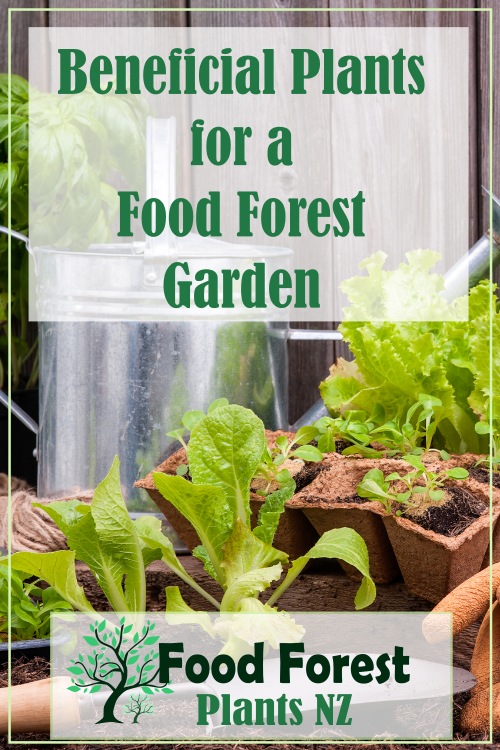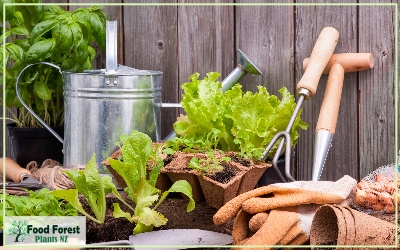Here is a big list of beneficial plants to grow in your permaculture food forest. There are plants for bees, herbal medicine, dynamic accumulators and chop and drop plants as well as a list of rhizome blocking plants for stopping invasive weeds naturally.
Food forest plants for insects/bees
Bees and insects need access to plants that are easy to get the pollen and nectar out of. These tend to be old-fashioned varieties where the flowers are wide open with shorter bodies.
Any flower of the umbrella type is perfect – carrots, fennel and dill are classic examples of these.
Here is a list of beneficial flowers that you can grow in your food forest garden to attract beneficial insects and bees.
Alyssum
Aquilegia
Asteraceae family: asters, sunflowers,
zinnias, cosmos and dandelions.
Boraginaceae family: borage,
comfrey and phacelia
Brassica family: Broccoli, Cabbage,
Mustard, Collards
Calendula
Californian poppy
Carrot
family (Apiaceae): fennel, coriander and
parsley
Cornflower
Delphinium
Forget-me-not
Foxglove
Fruit
trees: apple, pear, citrus and plum trees.
Lamiaceae (or mint)
family: basil, bee balm (monarda), catmint, lemon
balm
Mint
Lavender
Lobelia
Marigold
Nasturtium
Pansies
Phlox
Rosemary
Sage
Scabiosa
Snapdragons
Sweet
peas
Thyme
Food forest plants as dynamic accumulators
In the world of Permaculture we often find reference to plants known as Dynamic Accumulators.
Basically, this is the idea that certain plants (often deep-rooted ones) will draw up nutrients from the lower layers of the soil, and these nutrients will be stored in the plants’ leaves.
When the leaves fall in autumn and winter and are broken down, those stored nutrients are then incorporated into the upper layers of the soil where other plants will benefit from their deposition.
*Amaranthus Retroflexus
Bee Balm (Monarda spp.)
(p)
*Borage
Birdsfoot Trefoil (Lotus
corniculatus) (p)
*Chickweed (Stellaria media)
(p)
*Chicory (forage feast)
*Cleavers (Galium
aparine)
Coltsfoot (p)
Comfrey (p)
*Cup Plant
(Silphium
perfoliatum) (p)
*Garden Cress
*Corn
Salad
*Dandelion (Taraxacum officinale var sativa)
(p)
*Lamb’s Quarters
*Meadowsweet
(Filipendula ulmaria) (p)
*Miner’s Lettuce
*Stinging
Nettle (p)
*Plantago major (p)
*Salad
Burnet (p)
Hairy Vetch
*Yarrow (p)
*
= human edible
(p) = perennial
Green manure plants
Green manure is the idea that you can grow a lot of biomass on site to feed the soil. Usually it is either chopped and dropped, or lightly dug in just as it starts to flower.
In a permaculture food forest garden, you may choose to let the annual green manures grow and naturally self seed and die, which removes the manual labour required to harvest and dig in a green manure.
It is common practice to sow green manures at the beginning of creating a food forest garden as they help build the soil, as well as out compete the weeds due to their fast growing habits.
My favourite green manures include broad beans or their smaller cousin the tic bean, and buckwheat.
Alfalfa/lucerne*
Annual
Ryegrass
Arugula/Rocket
Buckwheat
Broad Beans/Fava
Beans*
Field Peas*
Hairy Vetch*
Mustard
Oats
Red
Clover*
Rye
Sudangrass
Teff
Wheat (Includes
Spelt, Triticale)
White Clover*
*Legumes. They add nitrogen to the soil as well as carbon mass by the way of leaves. Common combinations include Rye and Clover, Vetch and Oats and Peas and barley.
Good chop and drop plants for a food forest
Generally speaking, all of the plants on both the dynamic accumulators and green manures make the best chop and drop options for building up the soil in a food forest garden.
Chop and drop is a permaculture idea where you are growing much of the garden’s nutrition and mulch in place.
All you have to do is go along once or twice (or more) a year and chop the tops off the plants and allow the leaves and stalks to drop to the ground where they act as mulch and will naturally break down and start to feed the soil.
The most common plants to use as chop and drop in a food forest are probably comfrey along with some of the faster growing nitrogen fixing trees like Tree Lucerne (tagasate).
Rhubarb makes a good chop and drop option as you harvest the stalks leave the (non edible) leaves on the ground. They are great because they are so large and prolific.
Rhizome blocking plants for stopping weeds as a natural barrier
If you are like many areas in NZ, you probably have some sort of rhizome based invasive grass or weed right where you want your food forest to grow.
Mulching thickly will probably stop the grass from growing up and through (though only once the mulch is 30cm or more thick does it seem to totally give up trying to grow).
Around the edges of your food forest garden where the invasive grasses and weeds still grow, you can use thickly planted rows of densly rooted plants. These act as a natural rhizome grass barrier to help keep couch, quack, twich and other horrible grasses out.
For the natural rhizome barrier to be effective you will want it about 2 foot wide, and the plants spaced very closely together to allow them to establish their thick root network quickly.
Here are some rhizome blocking plants that you can use:
Sorrel
Turkish rocket
Yarrow
Vetiver grass
Rhubarb
Siberian iris
Mint
Burdock
Muscari bulbs
Chives
Periwinkle – Vinca Major
Japanese Mugwort
Oregano
Thyme
Garlic chives
Goldenrod
Sweet Cicely
Giant Perennial Sunflower
Jerusalem Artichokes
Be aware that many of the rhizome blocking plants can also be invasive themselves. However, they are easier to maintain and contain than the grasses that you are trying to keep out.
Most of them are also beneficial in other ways, so for me the benefits outweigh the negatives for sure.


